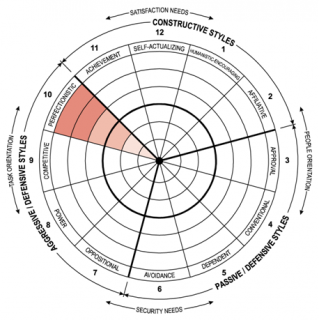In a previous blog, we introduced the Human Synergistics Circumplex™, a proven framework to measure, report, discuss and better understand individual and collective human behaviour, and their impact upon business and organisational performance (refer: Catching Smoke: A Proven Framework for Addressing Culture and Leadership).
Today’s blog focuses on one of the Aggressive/Defensive styles – Perfectionistic: what it is, how it can hinder your personal effectiveness and/or the performance of your business/organisation and, if you think you might need to, how you can you reduce your own perfectionistic tendencies or those in your workplace culture.

So Just What is the Perfectionistic Style?
Whether we’re looking at it from an individual leadership or broader workplace culture perspective, primary characteristics of the Perfectionistic style include the need to persist, to “work hard” and appear competent and independent.
Leaders high in the Perfectionistic style will tend to, for example:
- attach their own sense of worth to the accomplishment of tasks
- engage in unnecessary repetitive, ritualistic behaviour
- be overly-precise, and excessively concerned with avoiding mistakes, and
- place sometimes unreasonable demands on themselves and/or others.
Over time (and often under the watch of Perfectionistic leaders), the culture of a workplace can become Perfectionistic in nature. In Perfectionistic workplaces, participants feel expected to, for example:
- work long work hours
- never make a mistake
- set unrealistically high goals
- view work as more important than anything else, and
- appear to stay on top of everything, not let anything slip through the cracks, ever.
So Why Should I be Concerned?
Research over several decades by Human-Synergistics has consistently shown that workplaces high in the Perfectionistic style (and other Defensive styles) are significantly less effective than workplaces with predominantly Constructive cultures.
Indeed, primarily constructive workplaces:
- are 32% more able to effectively respond to changes in the external environment
- achieve 32% higher quality performance
- demonstrate 28% more effective teamwork
- have a 25% greater commitment to producing a quality result
- have individuals that are 32% more motivated, 26% more satisfied and 25% more likely to stay with the organisation.
Individuals engaged in highly Perfectionistic thinking and behaviour tend to find it tough to maintain their excessively high standards over an extended period of time (burnout and stress-related diseases are common). Perhaps also not surprisingly, those around them also tend to suffer, as do business outcomes.
- Personal relationships become strained as a result of unrealistic expectations and, often, a lack of recognition (“nothing is ever good enough”)
- Doing something “perfectly” generally takes longer than doing a good but not quite perfect job. Sometimes it’s OK to take more time (3 minute appendectomy anyone?), but quite often the extra time does not add much value and in fact can detract from service and other outcomes
- Perfectionistic individuals and cultures naturally focus on the details, often at the expense of the bigger picture, putting businesses/organisations at risk of missing the “make or break” opportunities and challenges
- Perfectionistic cultures can also lead individuals to engage in unconstructive behaviours (for example, focussing on “appearing” to work hard, hiding mistakes and avoiding blame)
- Retaining staff can be difficult in perfectionistic work cultures – they tend to be less motivating, provide less scope for learning and development, focus more on process compliance than outcomes, provide less opportunity for independent thinking and, to put it simply, wear people down.
OK, So How Can I Reduce Perfectionistic Tendencies?
If you’ve read this far and come to the conclusion that your own performance, and/or that of your business/organisation may be hindered by an overdose of Perfectionistic thinking and/or behaviour, there are some things you can you do to reduce its presence and get back on track.
At an individual leadership level, for example:
- Be aware of and understand the results of your perfectionistic tendencies. Are they helping or hindering your effectiveness, your relationships, your own health and wellbeing?
- Try being “not quite perfect” and see what happens (be selective and start small – leave the desk a bit untidy at the end of the day, send an email without checking it 5 times). Who knows, maybe the sky won’t cave in?
- Assess each task on its merits: does this particular task need to be perfect, very good though not necessarily perfect, or is it a case of OK is good enough etc…
- Try being less demanding of others and see what response you get. Also make an extra efforts to recognise their good work – “catch someone doing something right”
- Learn to delegate more, and begin to encourage others to make decisions within their defined areas of responsibility, and/or
- “‘Fess up” to it if things go wrong and it’s your responsibility. You may even feel relieved to have admitted it, and others may appreciate you acknowledging your human frailties.
At a collective/workplace level, for example:
- Make it “safe” for people to acknowledge mistakes and shortfalls, and regard them as learning opportunities (that said, there may of course be the rare occasions where the mistake or shortfall requires more substantial action, and that should not be avoided)
- Develop/review recognition structures and systems, to begin to balance what has probably been a tendency to over-focus on things that have been “not quite perfect”
- Try to design jobs that provide individuals with more autonomy, and/or
- Collaborate with others when setting goals, and build in a double-check to ensure that goals are challenging yet realistic
In subsequent articles, we’ll continue to look at the what, why and how of other workplace culture and personal leadership styles. Search our blog for the “Focus in Leadership and Culture” series of articles.
And please let us know if you’d like to explore the range of culture and leadership programs we have available to help transform your people, your team and your business/organisation.

